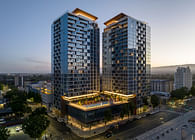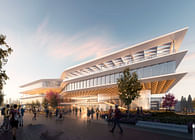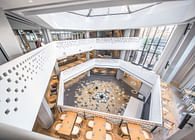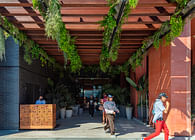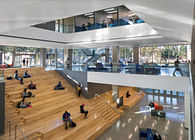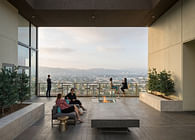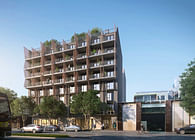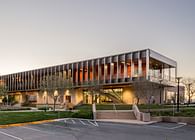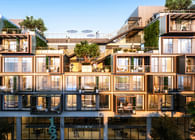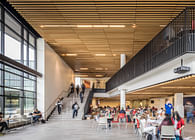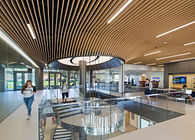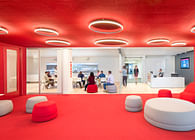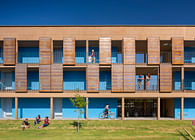

Black, Female, Latinx, Asian/Pacific Islander, LGBTQIA+ owned
Los Angeles | San Jose, CA | San Francisco, CA | New York, NY | San Diego, CA | Austin, TX | Denver, CO
Sparked by the nation’s tech-industry relocation to Austin, Texas, the neighborhood of East Austin is amid a substantial revitalization. This 357-unit project, will be one of the very first new, large scale, housing developments in this neighborhood destined to serve the housing needs of the young professionals who have relocated to the area.
Inspired by the neighborhood’s natural playground of creeks and the abundant formation of tree canopies, Pearl Springdale at 3707 Goodwin Ave. is meant to bring residents and passersby back to that sense of wonder and excitement of playing in the surrounding woods. Engaging with existing on-site trees, the project plays in and around these existing features, developing treehouse-like moments within a few unique units. The elevated roof deck, complete with a pool and clubhouse, extends the natural ground plane into the sky, providing a lush natural environment that frames views to the urban core of downtown Austin. The exterior material palette takes cues from the existing geology, using locally sourced brick as well as the material interpretations of the bark textures and foliage of the live oak trees common to the woodland experience throughout this region of Texas.
Located on the heavily trafficked Airport Blvd. the project’s triangular site proposed challenges in the development of the traditional wrap multifamily design approach. In addition, the site held a set of existing, mature trees that the design & development team hoped to keep in place or at least relocate on site. After studying numerous configurations, the 4-story parking structure was pushed to the north end of the site, with access off Goodwin Ave, a quiet transitional street that created a pleasant user experience. This allowed the design team to develop a courtyard around an existing mature pecan tree at the southern end of the site. The dappled southern light filtering through the canopy of the pecan tree creates a wonderful tree fort-like hangout within the active residential community. On the Springdale Road side of the project, the building massing inflects around an existing cedar elm tree, creating a new entry courtyard adjacent to the building’s lobby. This tree, with its brilliant and sculptural canopy, becomes the focal point of the entry experience. An existing live 0ak, with its 54” diameter trunk and massive canopy, was donated and relocated across the street onto the Springdale Green office development, becoming a featured specimen within that project’s park-like landscape design, allowing it to remain a community asset.
Besides the influences of the existing trees and the site geometry, the approach to the building design was marked by the three street conditions surrounding the Pearl’s site. Each frontage responds to unique parameters associated with one or more of the following: noise mitigation, access to daylight, pedestrian scale, and placemaking.
Airport Boulevard is the prime artery connecting residents of East Austin, the neighborhoods to the northeast, and the Austin Bergstrom International Airport. This creates a significant amount of traffic noise and activity. This façade used inset and recessed balconies at the units. The design uses the building massing as a natural buffer from this noise source and resulting in a more pleasant resident experience. Recessing the balconies also helps with the solar heat gain of the West facing façade, protecting living space from the harsh summer Texas sun. In consideration of the traffic speed and the lack of pedestrian engagement, the Airport façade reads more horizontal, meant to be experienced in a single glance at the speed of the car.
Springdale Road is the link to many of the new office and mixed-use development within East Austin. As a result, it has higher than average traffic usage. This became the street where the ‘Live-Work’ units and building lobby were located, in response to the higher degree of pedestrian and retail activity of the area. Balconies project off the façade of the building, leaning out to grab the daylight while also providing solar protection for neighboring units below. A continuous stoop connecting individual ‘Live-Work’ units helps to activate the street level and engage the larger community. Greater variation in the overall building massing occurs along Springdale, addressing the combined pedestrian and vehicular nature of its context.
Goodwin Ave is a much quieter local street in character. As the primarily north-facing façade on the project, it was critically important that we maximize daylight in all units. The massing here steps back as the building moves up vertically, allowing for daylight to begin to penetrate to the street level and the outdoor terraces along this façade. The deep property setback along Goodwin provides for substantial outdoor space for outdoor units. These mini ‘yards’ create a residential feel that is in keeping with the speed and scale of the surrounding single-family homes in the area.
We have addressed the corner confluences between each street with iconic architectural markers. Each corner is comprised of a similar DNA but configured to uniquely respond to the significance or each corner. These architectural moments are evocative of the ‘Treehouse’ structures amongst the woodland areas of these Austin neighborhoods and help create a symbolic gateway to the project and community.
Status: Built
Location: Austin, TX, US

